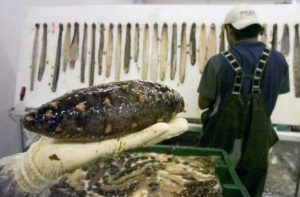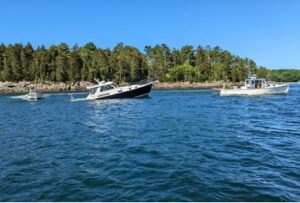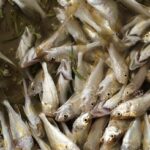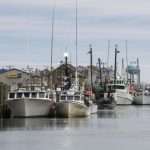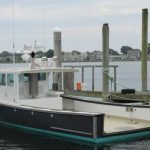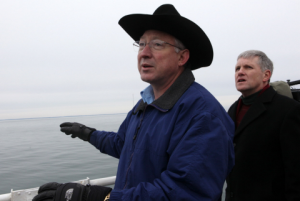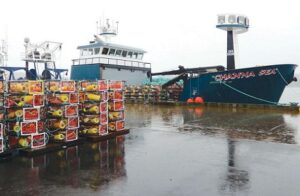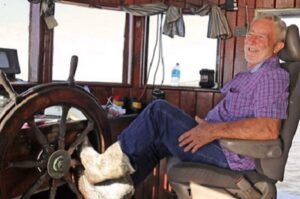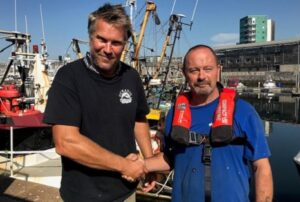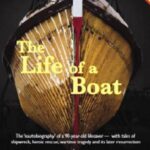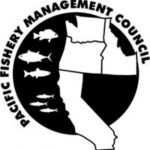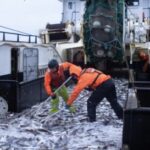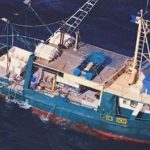Search Results for: Chris Roebuck
Stock Assessments Benefit from Rockhopper Trawl Efficiency Study
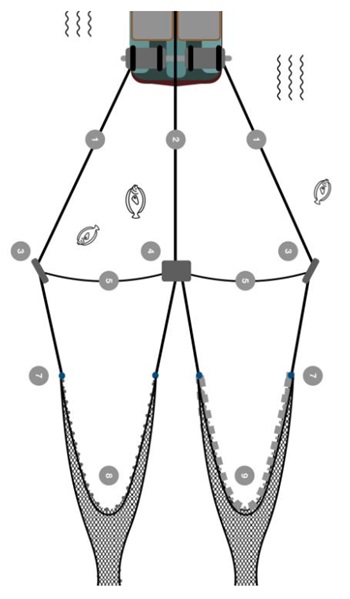 A collaborative study conducted aboard a Rhode Island-based commercial trawler from 2015 to 2017 is bearing fruit. It was led by the Northeast Fisheries Science Center and commercial fishermen interested in how catches of the same species varied depending on the type of trawl net used. Since 2019, stock assessment scientists have used the results from this Northeast Trawl Advisory Panel study in multiple stock assessments to ensure sustainable fisheries for several flounder species as well as monkfish and red hake. Specifically, the results help produce more accurate estimates of abundance which can increase the confidence in catch advice for some species. “Cooperative research is essential to obtain accurate assessments and catch advice in our nation’s fisheries,” said Chris Roebuck, former Northeast Trawl Advisory Panel member, commercial fisherman and participant in the experiment. “This research is an excellent example of collaboration between scientists and fishermen. It provided solid efficiency numbers for each targeted species,” he said. “The information produced was clearly the best available science and has the potential to ultimately influence catch advice for every species evaluated.” Photos, lots of links, more, >>click to read<< 12:29
A collaborative study conducted aboard a Rhode Island-based commercial trawler from 2015 to 2017 is bearing fruit. It was led by the Northeast Fisheries Science Center and commercial fishermen interested in how catches of the same species varied depending on the type of trawl net used. Since 2019, stock assessment scientists have used the results from this Northeast Trawl Advisory Panel study in multiple stock assessments to ensure sustainable fisheries for several flounder species as well as monkfish and red hake. Specifically, the results help produce more accurate estimates of abundance which can increase the confidence in catch advice for some species. “Cooperative research is essential to obtain accurate assessments and catch advice in our nation’s fisheries,” said Chris Roebuck, former Northeast Trawl Advisory Panel member, commercial fisherman and participant in the experiment. “This research is an excellent example of collaboration between scientists and fishermen. It provided solid efficiency numbers for each targeted species,” he said. “The information produced was clearly the best available science and has the potential to ultimately influence catch advice for every species evaluated.” Photos, lots of links, more, >>click to read<< 12:29
A unique educational experience, designed for fishermen, by fishermen
 The Marine Resource Education Program (MREP) offers fishermen, and others with a stake in healthy fisheries, an opportunity to learn the basics of fisheries science and how the fishery management process works. It provides an inside look at the fisheries science and management processes, demystifies the acronyms and vocabulary, and equips fishermen with the tools to engage in shaping regulatory action and participating in collaborative science.
The Marine Resource Education Program (MREP) offers fishermen, and others with a stake in healthy fisheries, an opportunity to learn the basics of fisheries science and how the fishery management process works. It provides an inside look at the fisheries science and management processes, demystifies the acronyms and vocabulary, and equips fishermen with the tools to engage in shaping regulatory action and participating in collaborative science.
MREP is offering two upcoming workshops that are organized and moderated by members of the local fishing community:
The Ecosystem-Based Fisheries Management Workshop offers an in-depth discussion on data inputs, management strategies, and what Ecosystem-Based Fishery Management may mean for fishermen in the future. It will be held from February 26-28 in New Bedford, MA.
Questions? Contact Chris Roebuck (Commercial Fisherman) at (401) 741-1831 or Libby Etrie at (978) 491-1848.
The Recreational Fisheries Workshop covers the basics of fisheries science and management with a special focus on topics of interest to the recreational fishing community. It will be held from March 20-22 in Hanover, MD.
Questions? Contact moderators Dave Sikorski (Mid-Atlantic) at (443) 621-9186 or Rick Bellavance (New England) at (401) 741- 5648.
For both workshops, lodging, meals and travel expenses are covered for participants who complete the entire program, and who are not otherwise funded to attend. You can apply for these workshops with the Gulf of Maine Research Institute.
For general questions about the program, contact Alexa Dayton, Gulf of Maine Research Institute, at 207-228-1645.
2017 Sweep Efficiency Study Targets Summer Flounder – Cooperative research program effort reveals a few surprises
 Testing the efficiency of different sweep types on fishing nets was the focus of twin trawling operations August 18-28 aboard the F/V Karen Elizabeth from Point Judith, RI. Chris Roebuck and his four-person crew aboard the 78-foot western-rigged stern trawler Karen Elizabeth conducted this year’s study with five staff members from the NEFSC’s Northeast Cooperative Research Program and the Fisheries Ecology and Oceans and Climate branches. The team targeted summer flounder in Southern New England from Montauk, Long Island to Nantucket and red hake in the western Gulf of Maine off Cape Ann, making a total of 103 good tows and collecting over 73,000 fish from species targeted by the study. click here to read the story 11:41
Testing the efficiency of different sweep types on fishing nets was the focus of twin trawling operations August 18-28 aboard the F/V Karen Elizabeth from Point Judith, RI. Chris Roebuck and his four-person crew aboard the 78-foot western-rigged stern trawler Karen Elizabeth conducted this year’s study with five staff members from the NEFSC’s Northeast Cooperative Research Program and the Fisheries Ecology and Oceans and Climate branches. The team targeted summer flounder in Southern New England from Montauk, Long Island to Nantucket and red hake in the western Gulf of Maine off Cape Ann, making a total of 103 good tows and collecting over 73,000 fish from species targeted by the study. click here to read the story 11:41
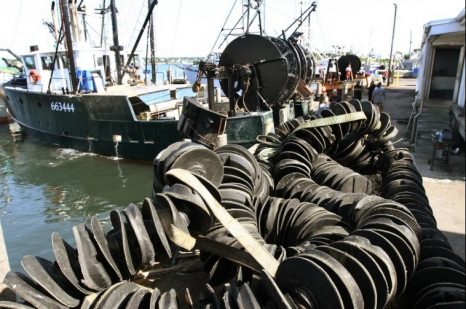
Cooperation between fishermen, regulators not just a fluke
Fisheries management is only as good as the science that it’s based upon. The better the science, the more effective the management. For the past three years, Point Judith fisherman Chris Roebuck has partnered with federal regulators to get a better handle on fish stocks, taking scientists with the National Oceanic and Atmospheric Administration out to sea on his 78-foot Western-rig stern trawler the Karen Elizabeth to help figure out where groundfish are and in what numbers. This summer’s trip wrapped up this week when the team of five researchers led by John Manderson, a senior ecosystem field scientist with NOAA’s Northeast Fisheries Science Center, and a four-man crew headed by Roebuck returned to port in Galilee with new information on summer flounder, red hake and other species. click here to read the story 21:48
Northeast Trawl Advisory Panel Members Witness Bigelow Survey Operations
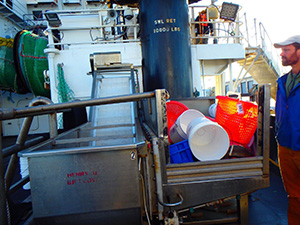 Three members of the Northeast Trawl Advisory Panel (NTAP), a new member of the New England Fishery Management Council and several of their colleagues made a day trip on the NOAA Ship Henry B. Bigelow October 11 to observe bottom trawl operations on the vessel, which is in the midst of the autumn bottom trawl survey. “The idea was to allow NTAP members to see how we operate under real survey conditions” said Rob Johnston, chief of the Northeast Fisheries Science Center’s (NEFSC) Ecosystems Surveys Branch. The group boarded the Bigelow early Tuesday morning, the first day of Leg 3 of the fall survey, at the Newport Naval Station in Rhode Island and headed offshore just south of Rhode Island Sound.,, “The trip on the Bigelow was very informative and answered many of the questions I had about the trawl mensuration system,” said Chris Roebuck, a fisherman from Pt. Judith, RI and a NTAP member. “The trip confirmed my belief that the survey is not at fault for the mismatches between what we see on the water and what comes out as an end result in management. Rather the interpretation of what that survey information means and how it is incorporated into management is to blame. The trip also made me realize that there are many more obstacles to overcome in our transition to industry vessels supplementing the Bigelow survey.” Read the story here 20:31
Three members of the Northeast Trawl Advisory Panel (NTAP), a new member of the New England Fishery Management Council and several of their colleagues made a day trip on the NOAA Ship Henry B. Bigelow October 11 to observe bottom trawl operations on the vessel, which is in the midst of the autumn bottom trawl survey. “The idea was to allow NTAP members to see how we operate under real survey conditions” said Rob Johnston, chief of the Northeast Fisheries Science Center’s (NEFSC) Ecosystems Surveys Branch. The group boarded the Bigelow early Tuesday morning, the first day of Leg 3 of the fall survey, at the Newport Naval Station in Rhode Island and headed offshore just south of Rhode Island Sound.,, “The trip on the Bigelow was very informative and answered many of the questions I had about the trawl mensuration system,” said Chris Roebuck, a fisherman from Pt. Judith, RI and a NTAP member. “The trip confirmed my belief that the survey is not at fault for the mismatches between what we see on the water and what comes out as an end result in management. Rather the interpretation of what that survey information means and how it is incorporated into management is to blame. The trip also made me realize that there are many more obstacles to overcome in our transition to industry vessels supplementing the Bigelow survey.” Read the story here 20:31
A CLEAN SWEEP ON THE OCEAN FLOOR By DON CUDDY
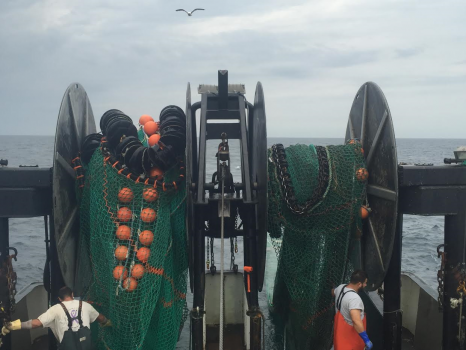 Most of the reporting in the media about commercial fishing and declining stocks in the Northeast dwells on how dire the situation has become with the fault generally attributed to fishermen and “overfishing.”
Most of the reporting in the media about commercial fishing and declining stocks in the Northeast dwells on how dire the situation has become with the fault generally attributed to fishermen and “overfishing.”
The view on the waterfront is very different however. Fishermen have long maintained that there is a huge disconnect between what they see on the water and the conclusions derived from the NOAA surveys and stock assessments. Their claims have been dismissed as self-serving. Now it seems the fishermen have a strong case. On a recent bottom trawl survey, a typical industry net caught four times as many flatfish as the rig used on the government trawl surveys.
For years fishermen have clamored for more collaborative research using industry vessels. They were largely ignored. But in August, Dr. Bill Karp, director of the Northeast Fisheries Science Center in Woods Hole, revealed a plan for NOAA Fisheries to shift all or part of its trawl surveys from its research vessel, the Henry B. Bigelow, to commercial fishing boats. At the same time, from August 7-21 the Point Judith fishing vessel Karen Elizabeth was at sea conducting a twin-trawl survey on behalf of the Science Center with a team of scientists working alongside the crew.
The boat was rigged to tow two nets simultaneously, each of the type used on the Bigelow, with one significant difference. One net was fitted with a rockhopper and the other had a chain sweep. Because different fish species behave differently, fishermen use a chain sweep, attached to the leading edge of the net and in contact with the sea floor, when targeting flatfish such as witch flounder. These fish hide in the sediment on soft bottom to evade predators. You will hear fishermen refer to fishing boats with rockhoppers as “hard bottom boats” because those boats typically go after other species such as cod and haddock which tend to be found over rocky or gravel bottom.
The Bigelow uses a rockhopper on every tow, despite surveying in our multispecies fishery. That is because this gear allows nets to be towed across a variety of habitats. A net equipped with a chain sweep is prone to snag on a rocky bottom. Its exclusive use of a rockhopper has been a point of contention with the fishermen since the Bigelow commenced operations in these waters. Fishermen openly questioned its accuracy in estimating flatfish abundance. The survey work on the Karen Elizabeth has provided the evidence that their skepticism is well founded. Here are some relevant quotes taken from the Science Center’s own paper, authored by the scientists who were on the Karen Elizabeth to conduct the study:
“On average, catch rates in the experimental chain sweep gear were about 4-fold the catch rates of the rockhopper sweep gear used on the standard survey.”
And here are some actual figures, also taken directly from the report: “A total of 53,495 witch flounder were caught during the 118 representative tows of the twin trawl, with 43,789 caught in the net with the experimental chain sweep and 10,706 caught in the net with the rockhopper sweep.”
These observations come as no surprise to the industry but it is startling to consider that our groundfishermen, many of whom are in straitened circumstances because of low catch limits, are constrained by surveys that are evidently underestimating stock abundance by a large factor, certainly with respect to witch flounder which were the principal focus of this study and more than likely with some of the other flounders such as yellowtail.
Chris Roebuck, owner and captain of the Karen Elizabeth told me that the witch flounder (fishermen know them as grey sole) caught on the survey trip amounted to 30,000 pounds which represents 4 percent of the TAC (total allowable catch) allotted to the fishing fleet for the whole year. On just one boat and in just two weeks! In theory a single boat could catch the entire yearly quota if it kept on fishing.
This example illustrates the fact that serious problems plague fishery management in New England. These problems are not, as some would have us believe, all attributable to rapacious fishermen. Groups with an agenda antithetical to fishing have been trying to sell the idea that the problems stem from “too many boats chasing too few fish.” In truth there are not many boats left and there are certainly a lot more witch flounder out there than the people at NOAA thought. I might also add that this is one of the best fish you could ever hope to find on your dinner plate.
The takeaway here is that solutions can be found if people continue to work together. NOAA Fisheries deserves credit for the willingness to partner with fishermen in undertaking this survey. The industry is hoping that it is an indication that the culture within NOAA is changing. We will withhold judgement until December when we learn whether the data gathered here will be accepted and incorporated into the next stock assessment.
Don Cuddy is program director at the Center for Sustainable Fisheries.
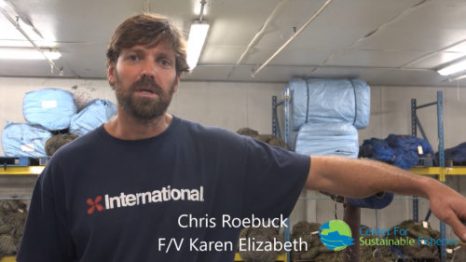
New England: Twin trawl survey validates industry concerns with NOAA assessment
Fishermen in New England do not believe that the survey vessel used by NOAA is catching fish in amounts comparable to what they haul up and have long questioned the fishing gear NOAA employs. To address these doubts a Rhode Island captain, Chris Roebuck went out and towed two nets simultaneously to compare the different gear types. here is what he found. Watch the video here 08:41

































